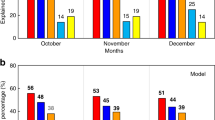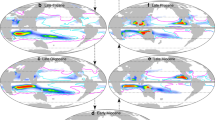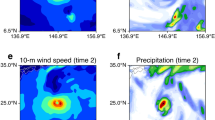Abstract
The El Niño/Southern Oscillation (ENSO) drives substantial variability in tropical cyclone (TC) activity around the world1,2,3. However, it remains uncertain how the projected future changes in ENSO under greenhouse warming4,5,6,7,8 will affect TC activity, apart from an expectation that the overall frequency of TCs is likely to decrease for most ocean basins9,10,11. Here we show robust changes in ENSO-driven variability in TC occurrence by the late twenty-first century. In particular, we show that TCs become more frequent (∼20–40%) during future-climate El Niño events compared with present-climate El Niño events—and less frequent during future-climate La Niña events—around a group of small island nations (for example, Fiji, Vanuatu, Marshall Islands and Hawaii) in the Pacific. We examine TCs across 20 models from the Coupled Model Intercomparison Project phase 5 database12, forced under historical and greenhouse warming conditions. The 12 most realistic models identified show a strong consensus on El Niño-driven changes in future-climate large-scale environmental conditions that modulate development of TCs over the off-equatorial western Pacific and the central North Pacific regions. These results have important implications for climate change and adaptation pathways for the vulnerable Pacific island nations.
This is a preview of subscription content, access via your institution
Access options
Subscribe to this journal
Receive 12 print issues and online access
$209.00 per year
only $17.42 per issue
Buy this article
- Purchase on Springer Link
- Instant access to full article PDF
Prices may be subject to local taxes which are calculated during checkout




Similar content being viewed by others
References
Camargo, S. J., Sobel, A. H., Barnston, A. G. & Philip, J. K. in Global Perspectives on Tropical Cyclones: From Science to Mitigation (eds Chan, J. C. L. & Kepert, J. D.) 325–360 (World Scientific, 2010).
Chand, S. S. & Walsh, K. J. E. Tropical cyclone activity in the Fiji region: spatial patterns and relationship to large-scale circulation. J. Clim. 22, 3877–3893 (2009).
Ramsay, H. A., Leslie, L. M., Lamb, P. J., Richman, M. B. & Leplastrier, M. Interannual variability of tropical cyclones in the Australian region: role of large-scale environment. J. Clim. 21, 1083–1103 (2008).
Cai, W. et al. Increasing frequency of extreme El Niño events due to greenhouse warming. Nat. Clim. Change 4, 111–116 (2014).
Collins, M. et al. The impact of global warming on the tropical Pacific Ocean and El Niño. Nat. Geosci. 3, 391–397 (2010).
Power, S., Delage, F., Chung, C., Kociuba, G. & Keay, K. Robust twenty-first-century projections of El Niño and related precipitation variability. Nature 502, 541–545 (2013).
Yeh, S.-W. et al. El Niño in a changing climate. Nature 461, 511–514 (2009).
Kim, S. T. & Yu, J.-Y. Two types of ENSO in CMIP5 models. J. Geophys. Res. 39, L11704 (2012).
Knutson, T. R. et al. Tropical cyclones and climate change. Nat. Geosci. 3, 157–163 (2010).
Murakami, H., Hsu, P.-C., Arakawa, O. & Li, T. Influence of model biases on projected future changes in tropical cyclone frequency of occurrence. J. Clim. 27, 2159–2181 (2014).
Tory, K. J., Chand, S. S., McBride, J. L., Ye, H. & Dare, R. A. Projected changes in late twenty-first-century tropical cyclone frequency in 13 coupled climate models from Phase 5 of the Coupled Model Intercomparison Project. J. Clim. 26, 9946–9959 (2013).
Taylor, K. E., Stouffer, R. J. & Meehl, G. A. An overview of CMIP5 and the experimental design. Bull. Am. Meteorol. Soc. 93, 485–498 (2012).
Emanuel, K. A. Downscaling CMIP5 climate models shows increased tropical cyclone activity over the 21st century. Proc. Natl Acad. Sci. USA 110, 12219–12224 (2013).
Camargo, S. J. Global and regional aspects of tropical cyclone activity in the CMIP5 models. J. Clim. 26, 9880–9902 (2013).
Wang, C., Zhang, L., Lee, S.-K., Wu, L. & Mechoso, C. R. A global perspective on CMIP5 climate model biases. Nat. Clim. Change 4, 201–205 (2014).
Tory, K. J., Dare, R. A., Davidson, N. E., McBride, J. L. & Chand, S. S. The importance of low-deformation vorticity in tropical cyclone formation. Atmos. Chem. Phys. 13, 2115–2132 (2013).
Horn, M. et al. Tracking scheme dependence of simulated tropical cyclone response to idealized climate simulations. J. Clim. 27, 9197–9213 (2014).
Peters, G. P. et al. The challenge to keep global warming below 2 °C. Nat. Clim. Change 3, 4–6 (2013).
Christensen, J. H. et al. in Climate Change 2013: The Physical Science Basis (eds Stocker, T. F. et al.) 1217–1308 (IPCC, Cambridge Univ. Press, 2013).
Vecchi, G. A. & Soden, B. J. Global warming and the weakening of the tropical circulation. J. Clim. 20, 4316–4340 (2007).
Stevenson, S. et al. Will there be a significant change to El Niño in the twenty-first century? J. Clim. 25, 2129–2145 (2012).
Trenberth, K. E. The definition of El Niño. Bull. Am. Meteorol. Soc. 78, 2771–2777 (1997).
Wang, H. et al. How well do global climate models simulate the variability of Atlantic tropical cyclones associated with ENSO? J. Clim. 27, 5673–5692 (2014).
Bell, R., Hodges, K., Vidale, P. L., Strachan, J. & Roberts, M. Simulation of the global ENSO–tropical cyclone teleconnection by a high-resolution coupled general circulation model. J. Clim. 27, 6404–6422 (2014).
Kim, H.-S. et al. Tropical cyclone simulation and response to CO2 doubling in the GFDL CM2.5 high-resolution coupled climate model. J. Clim. 27, 8034–8054 (2014).
Knapp, K. R., Kruk, M. C., Levinson, D. H., Diamond, H. J. & Neumann, C. J. The International Best Track Archive for Climate Stewardship (IBTrACS) unifying tropical cyclone data. Bull. Am. Meteorol. Soc. 91, 363–376 (2010).
Shaman, J. & Maloney, E. D. Shortcomings in climate model simulations of the ENSO-Atlantic hurricane teleconnection. Clim. Dynam. 38, 1973–1988 (2012).
Kalnay, E. et al. The NCEP/NCAR 40-Year reanalysis project. Bull. Am. Meteorol. Soc. 77, 437–471 (1996).
Rayner, N. A. et al. Global analyses of SST, sea ice and night marine air temperature since the late nineteenth century. J. Geophys. Res. 108, 4407 (2003).
Widlansky, M. J. et al. Changes in South Pacific rainfall bands in a warming climate. Nat. Clim. Change 3, 417–423 (2013).
Cai, W. et al. ENSO and greenhouse warming. Nat. Clim. Change 5, 849–859 (2015).
Johnson, N. C. & Xie, S.-P. Changes in the sea surface temperature threshold for tropical convection. Nat. Geosci. 3, 842–845 (2010).
Tory, K. J., Chand, S. S., Dare, R. A. & McBride, J. L. An assessment of a model-independent tropical cyclone detection procedure in selected CMIP3 global climate models. J. Clim. 26, 5508–5522 (2013).
Dunkerton, T. J., Montgomery, M. T. & Wang, Z. Tropical cyclogenesis in a tropical wave critical layer: easterly waves. Atmos. Chem. Phys. 9, 5587–5646 (2009).
Emanuel, K. A. & Nolan, D. S. In 26th Conf. on Hurricanes and Tropical Meteorology (Am. Meteorol. Soc., 10A.2., 2004); http://ams.confex.com/ams/pdfpapers/75463.pdf
Tippett, M. K., Camargo, S. J. & Sobel, A. H. A Poisson regression index for tropical cyclone genesis and the role of large-scale vorticity in genesis. J. Clim. 26, 2335–2357 (2011).
Menkes, C. E. et al. Comparison of tropical cyclogenesis indices on seasonal to interannual timescales. Clim. Dynam. 38, 301–321 (2012).
Bruyère, C. L., Holland, G. J. & Towler, E. Investigating the use of a genesis potential index for tropical cyclones in the North Atlantic basin. J. Clim. 25, 8611–8626 (2012).
Camargo, S. J. et al. Testing the performance of tropical cyclone genesis indices in future climates using the HiRAM model. J. Clim. 27, 9171–9196 (2014).
Song, Y. et al. Tropical cyclone genesis potential index over the western North Pacific simulated by CMIP5 models. Adv. Atmos. Sci. 32, 1539–1550.
McBride, J. L. & Zehr, R. Observational analysis of tropical cyclone formation. Part II: Comparison of non-developing versus developing systems. J. Atmos. Sci. 38, 1132–1151 (1981).
Davidson, N. E., Holland, G. J., McBride, J. L. & Keenan, T. D. On the formation of AMEX Tropical Cyclones Irma and Jason. Mon. Weath. Rev. 118, 1981–2000 (1990).
Murphy, B. F., Ye, H. & Delage, F. Impacts of variations in the strength and structure of El Niño on Pacific rainfall in CMIP5 models. Clim. Dynam. 44, 3171–3186 (2015).
Bellenger, H. et al. ENSO representation in climate models: from CMIP3 to CMIP5. Clim. Dynam. 42, 1999–2018 (2014).
Taschetto, A. S. et al. Cold tongue and warm pool ENSO events in CMIP5: mean state and future projections. J. Clim. 27, 2861–2885 (2014).
Grose, M. R. et al. Assessment of the CMIP5 global climate model simulations of the western tropical Pacific climate system and comparison to CMIP3. Int. J. Climatol. 34, 3382–3399 (2014).
Wilks, D. S. Statistical Methods in the Atmospheric Sciences Ch. 5 (Academic, 2006).
Chand, S. et al. The different impact of positive-neutral and negative-neutral ENSO regimes on Australian tropical cyclones. J. Clim. 26, 8008–8016 (2013).
Chand, S. et al. Impact of different ENSO regimes on southwest Pacific tropical cyclones. J. Clim. 26, 600–608 (2013).
Flato, G. et al. in Climate Change 2013: The Physical Science Basis (eds Stocker, T. F. et al.) 741–866 (IPCC, Cambridge Univ. Press, 2013).
Taylor, K. E. Summarizing multiple aspects of model performance in a single diagram. J. Geophys. Res. 106, 7183–7192 (2001).
Irving, D. B. Evaluating global climate models for the Pacific island region. Clim. Res. 49, 167–187 (2011).
Chan, J. C. L. Tropical cyclone activity over the Western North Pacific associated with El Niño and La Niña events. J. Clim. 13, 2960–2972 (2000).
Ramage, C. S. & Hori, A. M. Meteorological aspects of El Niño. Mon. Weath. Rev. 109, 1827–1835 (1981).
Collins, M. et al. A comparison of perturbed physics and multi-model ensembles: Model errors, feedbacks and forcings. Clim. Dynam. 36, 1737–1766 (2011).
Tebaldi, T. & Knutti, R. The use of multi-model ensemble in probabilistic climate projections. Phil. Trans. R. Soc. A 365, 2053–2075 (2007).
Knutti, R., Masson, D. & Gettelman, A. Climate model genealogy: generation CMIP5 and how we got there. Geophys. Res. Lett. 40, 1194–1199 (2013).
Acknowledgements
This project is supported through funding from the Australian Government’s National Environmental Science Programme (NESP). We thank S. Power, A. Dowdy, M. Wheeler and E. Ebert from the Australian Bureau of Meteorology for their valuable feedback. S.S.C. also thanks P. Vamplew and colleagues at Federation University Australia for their comments on this work.
Author information
Authors and Affiliations
Contributions
S.S.C. conceived and designed the study in discussion with K.J.T. and K.J.E.W., and wrote the initial draft of the paper. S.S.C., K.J.T. and H.Y. performed the analysis. All authors contributed to interpreting results, discussion of the associated dynamics, and improvement of this paper.
Corresponding author
Ethics declarations
Competing interests
The authors declare no competing financial interests.
Supplementary information
Supplementary Information
Supplementary Information (PDF 11694 kb)
Rights and permissions
About this article
Cite this article
Chand, S., Tory, K., Ye, H. et al. Projected increase in El Niño-driven tropical cyclone frequency in the Pacific. Nature Clim Change 7, 123–127 (2017). https://doi.org/10.1038/nclimate3181
Received:
Accepted:
Published:
Issue Date:
DOI: https://doi.org/10.1038/nclimate3181
This article is cited by
-
Distinct preceding oceanic drivers for interannual variation of summer tropical cyclone–induced rainfall in South and East China
Climate Dynamics (2024)
-
Climate processes and drivers in the Pacific and global warming: a review for informing Pacific planning agencies
Climatic Change (2023)
-
Clustering tropical cyclone genesis on ENSO timescales in the Southwest Pacific
Climate Dynamics (2023)
-
The 2023 Earthquake in Türkiye and Implications for China’s Response to Catastrophe
International Journal of Disaster Risk Science (2023)
-
The climate change policy integration challenge in French Polynesia, Central Pacific Ocean
Regional Environmental Change (2022)



